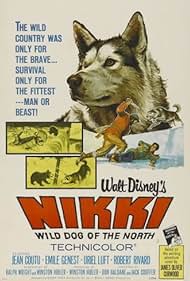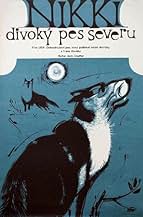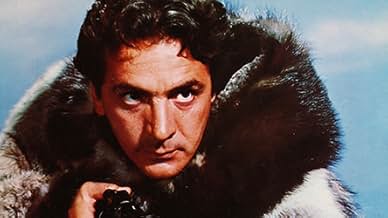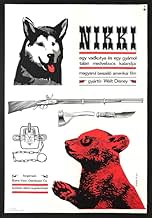VALUTAZIONE IMDb
6,6/10
539
LA TUA VALUTAZIONE
Aggiungi una trama nella tua linguaThe rugged Canadian wilderness is the backdrop to this story of a dog separated from his owner.The rugged Canadian wilderness is the backdrop to this story of a dog separated from his owner.The rugged Canadian wilderness is the backdrop to this story of a dog separated from his owner.
- Regia
- Sceneggiatura
- Star
- Premi
- 1 vittoria in totale
Émile Genest
- Jacques Lebeau
- (as Emile Genest)
James Barron
- Trapper
- (non citato nei titoli originali)
Recensioni in evidenza
I know most people think the Disney live-action movies of the 1960s were a rather pathetic bunch, made only to cash in on the organization's name...but if that's true, how do you explain their appeal? -Nikki- is a perfectly good film, with some amazing scenes of interaction between a Malamute pup and a bear cub. The setting--northern Canada--is lovely enough to captivate people, and of course it's a nice flick to show to your kids. One word of caution: some of the people portrayed in the "mining town" are a rowdy bunch, so you might want to wait 'til the kids are over 5 before you show 'em...just in case they start asking questions. (Don't worry, it's *rated* "G".)
'Nikki, Wild Dog of the North" is a live action animal film typical of the Disney studios in the sixties. Its stars are a dog that is part wolf (Nikki) and a bear, who grow up together. This is a story that feels like a Jack London tale, full of adventure and celebrating the natural world.
The filmmakers impose their story on some real action sequences and, probably, also stage their animal "stars" to conform to the desired story. A voice over is used to pull the parts of the story together and to provide human interpretations of animal behaviors. This anthropomorphism, while a large part of what makes the film enjoyable for some, trades in common misconceptions of animals and furthers inaccurate beliefs about animal psychology. When the narrator says the dog feels certain emotions or make judgments based upon rational decisions, it obscures the real nature of the animal.
While children will find much of the story adorable and engaging, they should be disabused of the conceit that the animals have thought processes like humans. Besides, it is not necessary for dogs to think and feel like humans for them to be good companions.
While the interactions between some of the animals usually can be explained by the filmmakers imposing their story on natural behavior, one has to wonder about the scenes involving the dog and a wolverine or the dog and some rats. Were any animals harmed in the making of this film or were animals put in harm's way?
In the end, there are some incredibly beautiful scenes of nature, including towering mountains and lovely blue waters in all seasons. And the values inherent in this film are kindness and respect for life.
The filmmakers impose their story on some real action sequences and, probably, also stage their animal "stars" to conform to the desired story. A voice over is used to pull the parts of the story together and to provide human interpretations of animal behaviors. This anthropomorphism, while a large part of what makes the film enjoyable for some, trades in common misconceptions of animals and furthers inaccurate beliefs about animal psychology. When the narrator says the dog feels certain emotions or make judgments based upon rational decisions, it obscures the real nature of the animal.
While children will find much of the story adorable and engaging, they should be disabused of the conceit that the animals have thought processes like humans. Besides, it is not necessary for dogs to think and feel like humans for them to be good companions.
While the interactions between some of the animals usually can be explained by the filmmakers imposing their story on natural behavior, one has to wonder about the scenes involving the dog and a wolverine or the dog and some rats. Were any animals harmed in the making of this film or were animals put in harm's way?
In the end, there are some incredibly beautiful scenes of nature, including towering mountains and lovely blue waters in all seasons. And the values inherent in this film are kindness and respect for life.
Nikki is a malamute / wolf hybrid (the narration informs us that he's 1/8th wolf) who's the devoted companion to late 19th century French-Canadian trapper Andre Dupas (Jean Coutu). One day, after they've acquired a black bear cub as a third member of the group, their canoe capsizes in some rapids, and the man and the animals are separated. The bulk of the tale details what happens as Nikki and the cub (dubbed Neewa) form a friendship and survive in the wilderness together.
The novel "Nomads of the North" by James Oliver Curwood (whose writings were also the basis for the 1989 film "The Bear") seems ideal fare for the Disney company, if perhaps a little intense and violent at times for the youngest of children. But there is still very little blood, and there are a steady parade of engaging animal characters (including a mean-tempered grizzly) to keep younger viewers enchanted. Ultimately, the film is one of those appealing tales that either enriches our appreciation for nature, or helps to develops it. The scenery (this was actually filmed in the Canadian wilderness) is as beautiful as one would expect it to be, and the pacing & storytelling pretty succinct. (This only runs an hour and 14 minutes). The final portions, with Nikki forced into a brief bout of dog-fighting, will be uncomfortable for members of the audience.
This does come off as a little cheesy and precious at times (with amusing, genial narration spoken by Jacques Fauteux), so it likely won't be to all tastes, but the animal action is top-notch. The animals are actually more engaging than the human characters, who aren't really fleshed out. All you need to know about trapper Jacques Lebeau (Emile Genest) is that he's a very bad man. Uriel Luft plays Lebeaus' Indian companion Makoki, a much more kind-hearted individual. Nikki himself is simply adorable.
Written by Ralph Wright & producer Winston Hibler, and directed by Jack Couffer (also one of the cinematographers) and Don Haldane. Since the cast members were French-Canadian, they did the dubbing for the French-language version.
Seven out of 10.
The novel "Nomads of the North" by James Oliver Curwood (whose writings were also the basis for the 1989 film "The Bear") seems ideal fare for the Disney company, if perhaps a little intense and violent at times for the youngest of children. But there is still very little blood, and there are a steady parade of engaging animal characters (including a mean-tempered grizzly) to keep younger viewers enchanted. Ultimately, the film is one of those appealing tales that either enriches our appreciation for nature, or helps to develops it. The scenery (this was actually filmed in the Canadian wilderness) is as beautiful as one would expect it to be, and the pacing & storytelling pretty succinct. (This only runs an hour and 14 minutes). The final portions, with Nikki forced into a brief bout of dog-fighting, will be uncomfortable for members of the audience.
This does come off as a little cheesy and precious at times (with amusing, genial narration spoken by Jacques Fauteux), so it likely won't be to all tastes, but the animal action is top-notch. The animals are actually more engaging than the human characters, who aren't really fleshed out. All you need to know about trapper Jacques Lebeau (Emile Genest) is that he's a very bad man. Uriel Luft plays Lebeaus' Indian companion Makoki, a much more kind-hearted individual. Nikki himself is simply adorable.
Written by Ralph Wright & producer Winston Hibler, and directed by Jack Couffer (also one of the cinematographers) and Don Haldane. Since the cast members were French-Canadian, they did the dubbing for the French-language version.
Seven out of 10.
More of a documentary than a film.
The premise, or at least the stuff that holds it together, to 'Nikki, Wild Dog of the North' is rather light; particularly for the first and second acts, the third has a little more meat on the bones.
There's also extremely questionable animal welfare, a lot of it could be trained but it's difficult not to be cynical with some of the stuff you see - especially across the opening twenty minutes. It affected my enjoyment, way more than a few other Disney films with similar issues.
Cast-wise it's almost non-existent, Jean Coutu and Émile Genest are solid as Andre and Jacques respectively. Jacques Fauteux narrates the film, he is arguably the only good part to this - his delivery is near perfect.
I can't honestly say I liked this as I simply didn't, the animal stuff alongside the weak plot makes for uninteresting viewing. Each to their own, as always.
The premise, or at least the stuff that holds it together, to 'Nikki, Wild Dog of the North' is rather light; particularly for the first and second acts, the third has a little more meat on the bones.
There's also extremely questionable animal welfare, a lot of it could be trained but it's difficult not to be cynical with some of the stuff you see - especially across the opening twenty minutes. It affected my enjoyment, way more than a few other Disney films with similar issues.
Cast-wise it's almost non-existent, Jean Coutu and Émile Genest are solid as Andre and Jacques respectively. Jacques Fauteux narrates the film, he is arguably the only good part to this - his delivery is near perfect.
I can't honestly say I liked this as I simply didn't, the animal stuff alongside the weak plot makes for uninteresting viewing. Each to their own, as always.
10Figaro-8
One thing can be said about Disney in the 50s and 60s, and that is it put out some great films with animal stars, from the True-Life Adventure series to "Old Yeller" and others. This film combines a True-Life filmmaking approach with a good adventure story, and the result is entertaining family fare. The Malamute and the bear cub are adorable! Both adventure and nature commentary are shown, combined with gorgeous on-location photography (filmed in Canada) and a nice music score.
Lo sapevi?
- QuizAll French-Canadian actors did dub themselves in the French version. No explanation if it was done either in Disney studios in Los Angeles, in Montreal's "Syncro-Québec" studio or SPS studio in Paris, France.
- ConnessioniEdited into Disneyland: Nikki, Wild Dog of the North: Part 1 (1964)
I più visti
Accedi per valutare e creare un elenco di titoli salvati per ottenere consigli personalizzati
- How long is Nikki, Wild Dog of the North?Powered by Alexa
Dettagli
- Data di uscita
- Paesi di origine
- Sito ufficiale
- Lingua
- Celebre anche come
- Nikki, il selvaggio cane del Nord
- Luoghi delle riprese
- Kananaskis Country, Alberta, Canada(exterior scenes)
- Aziende produttrici
- Vedi altri crediti dell’azienda su IMDbPro
- Tempo di esecuzione1 ora 14 minuti
- Proporzioni
- 1.33 : 1
Contribuisci a questa pagina
Suggerisci una modifica o aggiungi i contenuti mancanti

Divario superiore
By what name was La trappola di ghiaccio (1961) officially released in India in English?
Rispondi





















